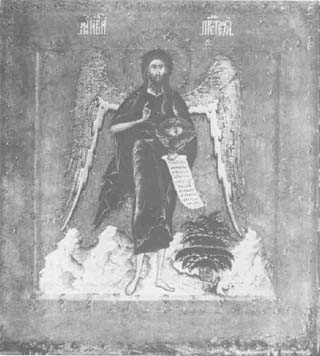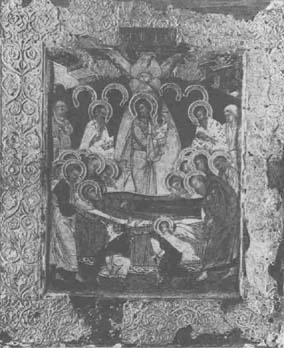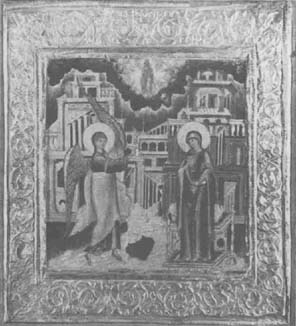
Bulletin 26, 1975
Home
Français
Introduction
History
Annual Index
Author &
Subject
Credits
Contact


![]()



"Christ
with Saints Alexandra and Agatha"
A Russian Icon in the National Gallery
by George Galavaris
Pages 1
| 2
| 3 | 4
| 5
| 6
| 7
Comparisons show that the master of the Ottawa icon displays less
stylization, greater fluidity, and more love for gold ornament and
that he renders the figures very differently from the master of the
Moscow icon. In the rendering of the figure of Christ in the Ottawa
icon, the most important stylistic feature is the fullness of the
body and the way the drapery relates to it. The right leg is
emphasized, relief-like; the volume is stressed by a series of
oval-shaped lines belonging to the drapery and is designed in a
broad manner (though their fine application recalls the technique of
book illumination). The drapery falls over the body in a natural way
and does not transform it into geometric shapes consisting of
flat areas of colour. In other words, and in terms of Medieval
style, there is a naturalness in the figure and in the drapery.
Furthermore, the broadness of the robes is emphasized by the
effect of the fluttering himation which adds a great deal of
movement to the figure of Christ. These features are not found in
the icon of the Korin collection. Instead one has to go to
seventeenth-century products of the Moscow school to find stylistic
parallels. (24) One icon depicting John the Baptist (see fig. 10), (25)
attributed to this school
(c.
1630), reveals the same artistic
principles. The volume of the body is never lost, and the system of
the oval-shaped lines forming the folds of the drapery over John's
right leg is similar to that of Christ's in our icon. This special
feature - the relative fullness of the body and the enhancement of
the volume by means of drapery - is a reflection of Byzantine art of
the Palaeologan period which constituted one of the most important
sources for the Moscow school of painting. The same type of drapery
and treatment of volume may be recognized in another icon of the
Moscow school (now in Berlin) that can be dated as from the first
half to the middle of the seventeenth century (see fig. 12). In this
work one sees the fine design and the abundant use of gold
striations found in our icon. (26) These gold lines on the drapery,
which ultimately derived from Byzantine art, recall the late
fifteenth- and early sixteenth-century works of the great Dionysius
and his circle. (27)
In contrast to Christ, the bodies of the kneeling saints and of the
angels appear flatter. One does see an attempt on the part of the
artist to relate the drapery to the body (the limbs underneath are
somehow distinguished); nevertheless it is the linear treatment
that prevails. A specific feature of these robes is the application
of highlights painted in curved, broken white lines that
follow the contours of the garment with a striking effect. This
characteristic again finds parallels in icons made in the Moscow
area during the seventeenth-century, as an example reproduced here
shows (fig.11). (28)
With regard to the rendering of the faces, those of the saints and
angels are more useful for stylistic comparisons. Christ's chin
and beard are later restorations (following, however,
seventeenth-century patterns) and so only the upper part of his face
can be considered. The highlights on all faces are in the form of
splodges rather than lines and this is a characteristic typical of
the seventeenth-century Moscow school of painting (cf. fig. 13). (29)
More specifically, one can point to an icon, now in Leningrad, which
can be assigned to the middle of the century (fig. 14). (30) As far as
the treatment of the faces is concerned, this work best resembles
our icon.
Clearly, on the basis of all these comparisons and considerations,
the Ottawa icon can be assigned to the seventeenth-century Moscow
school and a date ranging from the first half to the middle of the
century seems most probable. This conclusion can also be supported
by the palaeography of the inscriptions on the panel. Professor
Grebenschikov thinks, and rightly so, that best palaeographical
parallels are found in Moscovite writing of the late sixteenth- and
early seventeenth-centuries. (31)
There are several Russian icons dating from the fifteenth century
and later that have come down to us in their original repoussé
frames. But catalogue entries, whether published in Russia or
Europe, in most cases state that the cover is old or new; we are seldom
given particulars. Even if the facts are given, poor
reproductions do not facilitate stylistic comparisons. Even the
study by Goldberg, however important it may be for the publication
of stamps and marks on metal jewellery, is of little help in dating
silver covers that lack stamps of artists or of workshops. Moreover,
the comparative material that Goldberg illustrates is very limited
indeed. The lack of a comprehensive study of icon covers and
ornaments as well as the absence of marks or stamps on the basma
of
the Ottawa icon makes it extremely difficult to propose a precise
date for the silver cover, the nimbi, and the crown of Christ. (32)
The ornament on the basma, consisting mostly of a floral pattern
which takes the form of a scroll with stems springing from the
flower buds, is common in Russian silverware of the seventeenth and
eighteenth centuries. (33) But in actual design, in the complexity or
simplicity of the scroll, and in the shape of the leaves and the
type of rosettes, the ornament presents a great many variations. Two
dated examples illustrate some of the varieties and also aid us in
dating the metal cover of our icon. One, a silver compote dish in
Moscow dated 1685, displays the pattern in its engraved ornament
(fig. 15). The other is an embossed silver icon cover in the State
Historical Museum, Moscow, which dates from the end of the sixteenth-century
(fig. 16). (34) The technique is similar to that used in our
icon and the designs that adorn the upper and lower parts of the
frame belong to the same type or category of ornament exemplified
in our basma. Between these two dated examples, we can place another
metal cover which can be ascribed to the seventeenth century. It
covers an icon dated 1652, now in the Tretyakov Gallery, Moscow
(fig. 17). (35) It is actually with this metal cover that the frame of
our basma
finds its best stylistic parallel and a similar date for
both seems most probable.
Technical evidence has shown that the metal background must
be contemporary to the frame and this means that the entire basma
must be placed in the second half of the seventeenth century. If
this is correct, it follows that the basma
is somewhat later than
the panel itself, but not too far removed from it.
It would be a mistake to suppose that, in the process of covering
and ornamenting an icon, the nimbi and the crown were the last to be
added. Our knowledge about icons does not support this concept; a
case in point is the ornamentation of the famous Trinity icon by
Rublev, which is well documented. In this icon the haloes and the
frame were added at the same time (the late sixteenth-century) while
the process of decorating the panel with other elements - the metal
garments of the angels was one of them - lasted to the middle of the
eighteenth century. (36) But in the case of the Ottawa work we have
already argued, on the physical evidence itself, that the nimbi and
the crown of Christ were not planned when the metal cover was
applied. Therefore, we consider them to be later additions: they
may well have been added as late as the early nineteenth-century.
The stylized letters on the metal plaques do not contribute to the
solution of this problem. This type of script is found in earlier
inscriptions - the A, for example, with the point attached on
top-left occurs in eighteenth-century inscribed works. It is
possible that the inscriptions imitate earlier script and this,
perhaps, may explain the simplicity of the carving and the
stylization of the characters (although allowances should also be
made for the medium itself). Though these ornaments may be later
additions, it must be pointed out that such nimbi and crowns are
found today on other seventeenth-century icons (cf. fig. 9).
Next Page | St.
Agatha
1
| 2
| 3 | 4
| 5
| 6
| 7
Annual Index | Author & Subject | Credits | Contact
This digital collection
was produced under contract to Canada's Digital Collections program,
Industry Canada.
"Digital
Collections Program, Copyright
© National Gallery of
Canada 2001"